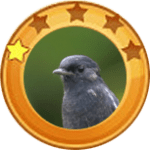- Home
- Shop
- Forest Series
- Grassland Series
- Desert Series
- Contact
- Home
- Shop
- Forest Series
- Grassland Series
- Desert Series
- Contact

Saxicola Series





Ideal Present for Children
Officially authorized by BENTLEY, this children’s ride-on is elaborately scaled down in accordance to the appearance of BENTLEY super-car with almost every detail of the bodywork preserved, such as the LED lights and the hydraulic supported lockable side doors. Molded with premium PP material, the body of this toy vehicle is glossy and realistic, sturdy and durable.
Handy and Comfortable
Just press on the red button on the right of the operating panel, the power will be on with simultaneous sound of engine. Benefited from the soft start setting, the acceleration of this toy vehicle is not violent, which ensures your child would not be shocked by uncomfortable feel caused by sudden change of speed.
Secure Driving
This toy vehicle could be manually operated by children as well as taken over the control by parents with the attached remote controller. Configured with an ergonomic seat and the 3-point safety belt, this toy could fix your child solidly onto the seat and effectively prevent the danger of falling off the car or hitting on the steering wheel during driving.
Abundant Recreation
Except the backlight for the dash board and volume adjusting, this children’s toy car has an easy access to rich audio resources through its TF card slot, 3.5mm AUX input and USB interface, adding much extra joy and relaxation for the driving experience in English-learning mode, story-telling mode and nursery rhyme singing mode, which could be manipulated by the two buttons on the steering wheel.


CHARACTERISTICS
The Chipmunk is a member of the family Mammalia, Rodentia and Sciuridae. It is also known as the Striped Squirrel, the Timber Tiger and the Mini-bear. The body length among most Chipmunks ranges from 5.5 to 6.3 inches and the tail length is 5 Inches. Chipmunks typically weigh about 0.02 pounds and live about 5 to 10 years. They have small but prominent ears which face forwards, and small eyes on the sides of their heads. Most wild Chipmunks are lively.


Lorem ipsum dolor sit amet, consectetur adipiscing elit. Ut elit tellus, luctus nec ullamcorper mattis, pulvinar dapibus leo.


CHARACTERISTICS
The Pied Bushchat is a small passerine bird. At 13 cm (5.1 in), the Pied Bushchat is slightly smaller than the Siberian stonechat, although it has a similar dumpy structure and upright stance. The male is black except for a white rump, wing patch and lower belly. The iris is dark brown, the bill and legs black. The female is drab brown and slightly streaked. Juveniles have a scaly appearance on the underside but dark above like females.

RANGE AND HABITAT
The Pied Bushchat is a resident breeder in tropical southern Asia from the Greater Middle East through the Indian subcontinent eastwards to Indonesia. They colonized Papua New Guinea around 1950. It is found in open habitats including scrub, grassland and cultivation.

DIET
The Pied Bushchat picks up insects mainly from the ground.

BEHAVIOR
Divided into about 16 subspecies, the species is a well-known bird that majorly enjoys in rural or open grasslands. Birds of this species especially build nests on walls. Their nests are made from grass and animal hair/fur.
The breeding season is mainly from February to August with a peak from March to June. Males sing from prominent perches. The whistling call is somewhat like that of an Indian robin. The nest is built in a hole in a wall or similar site lined with grass and hair, and two to five eggs are laid.

The Chipmunk is a member of the family Mammalia, Rodentia and Sciuridae. It is also known as the Striped Squirrel, the Timber Tiger and the Mini-bear. The body length among most Chipmunks ranges from 5.5 to 6.3 inches and the tail length is 5 inches. Chipmunks typically weigh about 0.02 pounds and live about 5 to 10 years. They have small but prominent ears which face forwards, small eyes on the sides of their heads. Most wild Chipmunks are lively.
The Red Squirrel, a member of the Sciuridae, is an arboreal, omnivorous rodent often referred to as a Forest Seeder and folklore as the Devil King Squirrel.
The Arizona Gray Squirrel, also known as the American Gray Squirrel, is a member of the family Rodentia and Sciuridae. It is small in size, with gray fur and a belly between white and cream. It has long ears, no tufts of fur and a fluffy tail edged in white. The body is about 16-20 inches long and weighs up to 1.4 pounds.
The Rock Squirrel, also known as Sao Maozi or Stone Mouse, belongs to the rodent and is a species in the family Sciuridae. The most common natural predators of the Rock Squirrel include bobcats, owls, eagles and snakes. Though the Rock Squirrel is cute, alert, and courageous, it is still considered a pest due to its habit of destroying crops.
The Abert’s Squirrel is a member of the genus Sciurus with a body length of 18-22.8 inches, a tail length of 7.5-9.8 inches and a weight of 2.2 pounds, and can live up to 10 years in the wild. Its most distinctive feature is tassels of fur about 0.8-1.2 inches long at the tip of its ears, which looks very interesting. In addition, it is alert and agile.

Pied Bushchat: ‘Stirrings Beyond Sense – With a Start, a Bounce, a Stab!’
Although rare in Bangladesh, the bird is quite widespread; and can be found in some 20 countries from Iran in the west to Vietnam, Indonesia and the Philippines in the east.
We were thrilled to spot a strange black bird on a painted stone over a hilltop on the Quantum campus at Lama in Bandarban. Hundreds of colourful boulders were placed on a green, round mound for people to sit and meditate.
The feathered friend sitting still on a coloured rock under the bright morning sun was undoubtedly a Pied Bushchat, one of the rare birds of Bangladesh found only in the hill districts.
On that quiet Saturday morning, the wide-eyed Pied Bushchat was the only taker of one colourful rock out of the hundreds placed for meditation on top of a hillock. We had no doubt that the good bird was meditating; but could not speculate whether it was paying attention to its breath, feeling or an idea. We believe that the birds of the world have been practising daily meditation long before Patanjali wrote his Yoga Sutras some sixteen centuries ago.
The Pied Bushchat on the rock did not meditate for more than a minute. With a nippy twitch of its tail the bird quickly brought its attention back to the green grasses between the boulders. It jumped out of the colourful rock and disappeared into the maze of grasses once a minute’s meditation was done. Meditation for a minute may, however, be pretty long for one morning in the short span of the little bird’s life.
We saw the bright white patches on the two black wings shine momentarily as the bird dived from the stone. A sitting male Pied Bushchat looks all black except for a little white patch at the base of its tail. The white wing-patches flash only when the male takes off. That’s a signal to other male Pied Bushchats to stay out of its feeding territory. A male not heeding that signal is vigorously chased out of the area.
A female or a juvenile Pied Bushchat, however, can enter a male’s territory at will. The females and juveniles are coloured brown to keep them out of territorial conflict. Pied Bushchats use the colour black with bits of white emblems for their martial outfit only. Only an adult male has the black dress with the white badges. Two birds in those black outfits cannot coexist in a single patch of grass or scrub on a hill.
That striking difference between the male and the female Pied Bushchats fascinated the indigenous people of Nilgiri hills in India thousands of years before. For them the Pied Bushchats elucidated why human males and females differ so greatly. Pied Bushchats were the first male and female in the origin story of the Kota people of Nilgiri.
The male Pied Bushchat soon flew out of the grass to perch on the bamboo grove that skirted the hillock in Lama. On its low perch it sat upright and uptight; with its keen dark eyes it continued to scan the grassland below; and stayed ever ready to dive into the grass at any moment. The lives of these birds depend on their ability to spot and grab tiny insects crawling through the endless maze of weeds and grass close to the ground.
All chats, thrushes and robins feed on small bugs and beetles crawling on the ground. These birds live close to the ground, stay alert forever and hunt in short bursts of energy. The keenest of nature watching English poet Ted Hughes observed a thrush hunting an insect and wrote the following riveting lines:
.. a poised
Dark deadly eye, those delicate legs
Triggered to stirrings beyond sense
– with a start, a bounce, a stab;
We harked back to those lines as we watched the big, dark eyes of the Pied Bushchat and its repeated dives into the grass. We could not figure out how often the little bird got its meal and how many times it returned to the perch thwarted. We never, however, saw the bird look drained, disappointed or disconsolate. The little meditation it did on the mound has probably, been working.
The handsome male did not seem to mind our presence on the mound and perhaps appreciated our quiet and unobtrusive ways. Cheerily it flew once to the top of the golden bamboo grove and then to the overhead cable, and sang a little repertoire of songs: chip chip chrew whit whit tit wheee wheee whix … All the while the little bird kept its dark eyes focused to the clear blue sky above.
While the big, black eyes are not very visible in the all-black face of a male Pied Bushchat; those are very prominent, poignant and pretty on a female’s face. On the uniform brown face of a female it is easy to see how big, dark and deep the eyes are. The eyes of a juvenile are equally big, bold and appealing on its spotted dark brown face.
Probably for those beautiful eyes, the Pied Bushchats once became popular cage-birds in Bengal, although it was not easy to maintain insectivorous birds as pets. The other reasons of those little birds’ popularity with the Bangali bird-fanciers of the past centuries were the readiness of the males to sing often in the cage and the females’ proclivity to tweet in reply.
In Bengal, the Pied Bushchats breed in the early monsoon. They nest in natural cavities of trees from where people once collected the nestlings for the pet trade. That unfortunate trade still goes on in some countries of Southeast Asia. Although rare in Bangladesh, the bird is quite widespread; and can be found in some 20 countries from Iran in the west to Vietnam, Indonesia and the Philippines in the east.
To the east, the Pied Bushchat colonised Papua New Guinea as recently as the mid-twentieth century. No wonder some indigenous people there see it as a messenger from the gods.
On that serene morning in Lama we also greeted the Pied Bushchat as an important emissary of Mother Nature.
Our plan is simple: to devote a portion of the first day of each year to a stroll in some wild place and find as many birds as we can. It’s a small way for us and our child to stay in touch with life as nature sees it. So I’m glad to report that our inaugural bird walk bore rewarding fruit, in the form of a small creature with a hint of the devil about him.
To begin our new tradition, we followed the advice of David Lindo and took a walk around Wormwood Scrubs, a nature reserve in a part of London best known for the prison of the same name. The sun was out and the sky cloudless. In just over an hour we had hit our modest target of 15 species.
The highlight was a male Stonechat just like the one in the photo above. I used to see this species back home on the island of Jersey but never expected to find it so close to the centre of big old urban London. As I watched the bird forage I realised how little I knew about this species apart from its name. Here’s what I have since learned…
This plucky little creature is rare among insect-eating birds in braving the British winter instead of flying South. It gets its name from the noise it makes when alarmed — a sharp “tyeck!-tyeck!” that you can recreate if you strike one pebble against another. But like most British birds, it has several other names that have fallen into obscurity. They include Blacky-top, Chickstone, Furze Chitter, Stanechacker, Stane Chipper and Stonesmith. Some of these refer to the way the bird will jerk its tail and beat a stone on which it perches.
So far, so standard, but the Stonechat also features in some stories from near-forgotten folklore. One says that toads will sit on, and even hatch, a Stonechat’s eggs when it leaves the nest. Another says the bird carries a drop of the devil’s blood. A Scottish rhyme warns that anyone who meddles with the birds nest “will never rest, will meet the pest”. To ram the message home it adds that the devil will break the back of anyone who dares to take the bird’s eggs.
But the bird was only a blessing as it brightened our day. We didn’t expect to meet an avian emissary of Satan but I’m glad we did. Life’s more interesting with a splash of colour — like that bloodspot on the Stonechat’s chest. I hope our future New Year’s walks produce similar surprises.



Follow Us: